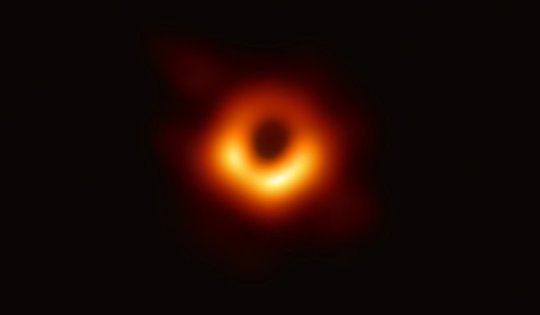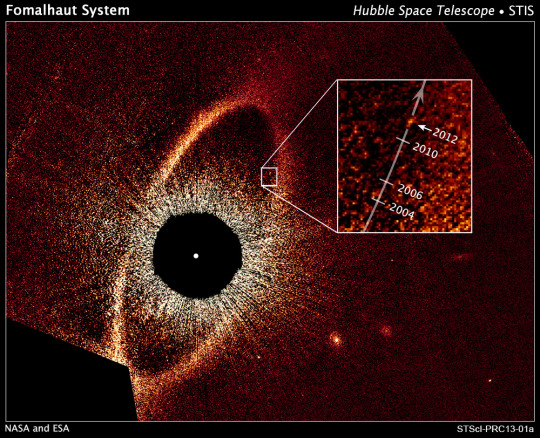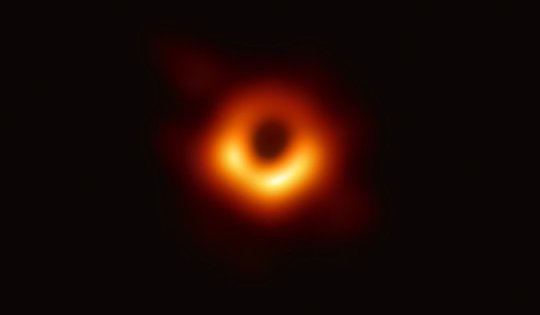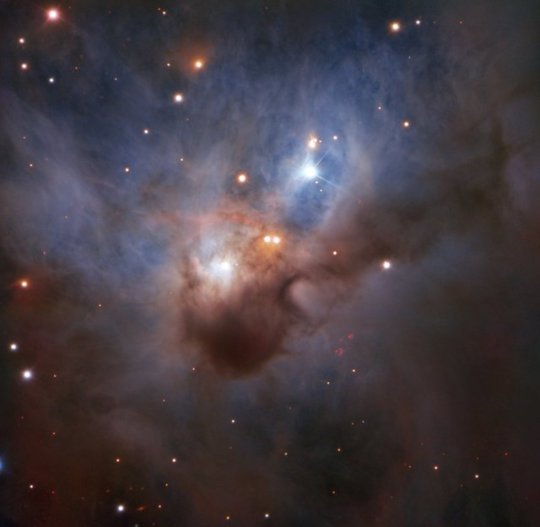From our atmosphere to borders of the observable universe.
Don't wanna be here? Send us removal request.
Photo

Messier 81
One of the brightest galaxies in planet Earth's sky is similar in size to our Milky Way Galaxy: big, beautiful Messier 81. Also known as NGC 3031 or Bode's galaxy for its 18th century discoverer, this grand spiral can be found toward the northern constellation of Ursa Major, the Great Bear. The detailed telescopic view reveals M81's bright yellow nucleus, blue spiral arms, pink starforming regions, and sweeping cosmic dust lanes. Some dust lanes actually run through the galactic disk (left of center), contrary to other prominent spiral features though. The errant dust lanes may be the lingering result of a close encounter between M81 and its smaller companion galaxy, M82. Scrutiny of variable stars in M81 has yielded one of the best determined distances for an external galaxy -- 11.8 million light-years. Credit: Paolo De Salvatore (Zenit Observatory)
#space#astronomy#cosmos#science#astrophotography#universe#cosmology#galaxy#spiral galaxy#Messier 81#M81
853 notes
·
View notes
Photo

A Cosmic Rose: The Rosette Nebula in Monoceros
The Rosette Nebula, NGC 2237, is not the only cosmic cloud of gas and dust to evoke the imagery of flowers, but it is the most famous. At the edge of a large molecular cloud in Monoceros some 5,000 light years away, the petals of this cosmic rose are actually a stellar nursery. The lovely, symmetric shape is sculpted by the winds and radiation from its central cluster of hot young, O-type stars. Stars in the energetic cluster, cataloged as NGC 2244, are only a few million years young, while the central cavity in the Rosette Nebula, is about 50 light-years in diameter. The nebula can be seen with a small telescope toward the constellation of Monoceros, the Unicorn. This natural appearing telescopic portrait of the Rosette Nebula was made using broadband and narrowband filters, because sometimes roses aren't red. Credit: Jean Dean
#space#astronomy#cosmos#science#astrophotography#universe#cosmology#nebula#Rosette nebula#NGC 2244#NGC 2237#star cluster#emission nebula#Caldwell 49
1K notes
·
View notes
Photo

Re: M87 black hole image
As the post from yesterday was my first to get that many notes I feel I have to address it somehow and maybe try to answer some comments on it.
• Many of you mentioned Katie Bouman, who was the scientist that developed the algorithm that was used to create the image of the black hole. Yay for women in science!
Here’s her TED-talk ”How to take a picture of a black hole”. • Many of you also mentioned NASA... Well, NASA had pretty much nothing to do with this (I may be taking this too personally as a European, everything space related gets credited to NASA by the public haha). This image was made possible by the Event Horizon Telescope team. • Speaking of telescopes, the ones used to get this picture were not what people usually think when imagining a telescope. As the black hole is a very tiny object in the scale of the universe, and as it can’t be seen in visible light, regular telescopes can not get a picture like this. The image was taken using radio telescopes that receive radio waves from astronomical radio sources. The light surrounding the black hole emits strong radio signals, and with the radio telescopes and Katie Bouman’s algorithm the EHT team were able to create the image. • So, it is NOT a photo (so your Android vs iPhone fight in the comments is pointless :D ) • The image just proves what scientists have been thinking a black hole looks like. On the left is the actual image of the black hole, in the center a simulation of what it could look like, and on the right that same simulation blurred to match the Event Horizon Telescope’s resolution:

• Someone asked if we should be concerned about this. No! At least if they meant that maybe we should be afraid that the black hole is going to come and swallow the Earth or something. Supermassive black holes in galaxy centers are normal. The Milky Way has one, and the EHT tried to get an image of that too, but at least for now they haven’t been successful. But no, there’s nothing to be scared or concerned of. • Someone said “Correction: M87 is between Sagittarius and Scorpio star constellations. For more information look for Sagittarius A.“ Ah, well, no. M87 is a galaxy and this black hole is in the center of it. M87 is located in the constellation Virgo. Sagittarius A* is the supermassive black hole in our galaxy’s center, and is indeed located between constellations Sagittarius and Scorpius. • A lot of Eye of Sauron jokes... But we already have an Eye of Sauron in space! It’s actually nicknamed Eye of Sauron.

And I guess that’s about all I needed to say. I’m not a scientist myself but if there’s something you wanna know, I’ll try my best to answer! Also I’m sorry if there’s spelling mistakes or anything, English is not my native language.
#space#astronomy#cosmos#science#astrophotography#universe#cosmology#black hole#M87#Messier 87#EHT#Event Horizon Telescope#supermassive black hole#eye of sauron#Fomalhaut
673 notes
·
View notes
Photo

Astronomers Capture First Image of a Black Hole
The Event Horizon Telescope (EHT) — a planet-scale array of eight ground-based radio telescopes forged through international collaboration — was designed to capture images of a black hole. Today, in coordinated press conferences across the globe, EHT researchers revealed that they have succeeded, unveiling the first direct visual evidence of a supermassive black hole and its shadow. The image reveals the black hole at the centre of Messier 87, a massive galaxy in the nearby Virgo galaxy cluster. This black hole resides 55 million light-years from Earth and has a mass 6.5 billion times that of the Sun. Supermassive black holes are relatively tiny astronomical objects — which has made them impossible to directly observe until now. As the size of a black hole’s event horizon is proportional to its mass, the more massive a black hole, the larger the shadow. Thanks to its enormous mass and relative proximity, M87’s black hole was predicted to be one of the largest viewable from Earth — making it a perfect target for the EHT. The shadow of a black hole is the closest we can come to an image of the black hole itself, a completely dark object from which light cannot escape. The black hole’s boundary — the event horizon from which the EHT takes its name — is around 2.5 times smaller than the shadow it casts and measures just under 40 billion km across.
Credit: ESO
#space#cosmos#science#astrophotography#universe#cosmology#black hole#event horizon#Event Horizon Telescope#EHT#Messier 87#M87#galaxy#supermassive#supermassive black hole#astronomy#radioastronomy
51K notes
·
View notes
Photo

A Cosmic Bat in Flight
Hidden in one of the darkest corners of the Orion constellation, this Cosmic Bat is spreading its hazy wings through interstellar space two thousand light-years away. It is illuminated by the young stars nestled in its core — despite being shrouded by opaque clouds of dust, their bright rays still illuminate the nebula. Too dim to be discerned by the naked eye, NGC 1788 reveals its soft colours to ESO's Very Large Telescope in this image — the most detailed to date.
Credit: ESO
#space#astronomy#cosmos#science#astrophotography#universe#cosmology#NGC 1788#nebula#VLT#Very Large Telescope
522 notes
·
View notes
Photo

Globular cluster NGC 4147
This globular cluster, NGC 4147, seen with the NASA/ESA Hubble Space Telescope, was one of many which were used by astronomers to measure the total mass of the Milky Way.
NGC 4147 is located about 60 000 light-years from Earth in the northern constellation of Coma Berenices (the Berenice's hair).
Credit: ESA/Hubble & NASA, T. Sohn et al.
#space#astronomy#cosmos#science#astrophotography#universe#cosmology#star cluster#globular cluster#NGC 4147#Hubble#Hubble Space Telescope#HST
668 notes
·
View notes
Photo

Crescent Enceladus
Peering from the shadows, the Saturn-facing hemisphere of tantalizing inner moon Enceladus poses in this Cassini spacecraft image. North is up in the dramatic scene captured during November 2016 as Cassini's camera was pointed in a nearly sunward direction about 130,000 kilometers from the moon's bright crescent. In fact, the distant world reflects over 90 percent of the sunlight it receives, giving its surface about the same reflectivity as fresh snow. A mere 500 kilometers in diameter, Enceladus is a surprisingly active moon. Data collected during Cassini's flybys and years of images have revealed the presence of remarkable south polar geysers and a possible global ocean of liquid water beneath an icy crust. Credit: Cassini Imaging Team, SSI, JPL, ESA, NASA
#space#astronomy#cosmos#science#astrophotography#universe#cosmology#Enceladus#Saturn#moon#Cassini#Cassini spacecraft
364 notes
·
View notes
Photo

Dramatic Jupiter
Dramatic atmospheric features in Jupiter’s northern hemisphere are captured in this view from NASA’s Juno spacecraft. The new perspective shows swirling clouds that surround a circular feature within a jet stream region called "Jet N6."
This color-enhanced image was taken at 9:20 a.m. PST on Feb. 12, 2019 (12:20 p.m. EST), as the spacecraft performed its 18th close flyby of the gas giant planet. At the time, Juno was about 8,000 miles (13,000 kilometers) from the planet's cloud tops, above a latitude of approximately 55 degrees north. Credit: NASA/JPL-Caltech/SwRI/MSSS/Kevin M. Gill
#space#astronomy#cosmos#science#astrophotography#universe#cosmology#Jupiter#Juno#juno spacecraft#Jet N6
1K notes
·
View notes
Photo

Colliding galaxies
Located in the constellation of Hercules, about 230 million light-years away, NGC 6052 is a pair of colliding galaxies. They were first discovered in 1784 by William Herschel and were originally classified as a single irregular galaxy because of their odd shape. However, we now know that NGC 6052 actually consists of two galaxies that are in the process of colliding. A long time ago gravity drew the two galaxies together into the chaotic state we now observe. Stars from within both of the original galaxies now follow new trajectories caused by the new gravitational effects. However, actual collisions between stars themselves are very rare as stars are very small relative to the distances between them (most of a galaxy is empty space). Eventually things will settle down and one day the two galaxies will have fully merged to form a single, stable galaxy. Our own galaxy, the Milky Way, will undergo a similar collision in the future with our nearest galactic neighbour, the Andromeda Galaxy. Although this is not expected to happen for around 4 billion years so there is nothing to worry about just yet. Credit: ESA/Hubble & NASA, A. Adamo et al.
#space#astronomy#cosmos#science#astrophotography#universe#cosmology#NGC 6052#galaxy#galaxies#colliding galaxies#galaxy collision#Hubble#Hubble space telescope#HST
919 notes
·
View notes
Photo

Lagoon Nebula by SPECULOOS
If you had a brand new state-of-the-art telescope facility, what would you look at first? Researchers at the SPECULOOS Southern Observatory — which comprises four small telescopes, each with a 1-metre primary mirror — chose to view the Lagoon Nebula. This magnificent picture is the result, and is one of the SPECULOOS’ first ever observations. The nebula is a cloud of dust and gas in our galaxy where new stars are being born, and is found roughly 5000 light-years from us.
Credit: ESO
#space#astronomy#cosmos#science#astrophotography#universe#cosmology#Lagoon nebula#Messier 8#M8#NGC 6523#Sharpless 25#RCW 146#Gum 72#nebula#emission nebula#SPECULOOS
273 notes
·
View notes
Photo

Sharpless 249 and the Jellyfish Nebula
Normally faint and elusive, the Jellyfish Nebula is caught in this alluring telescopic field of view. The entire scene is a two panel mosaic constructed using narrowband image data, with emission from sulfur, hydrogen and oxygen atoms shown in red, green and blue hues. It's anchored right and left by two bright stars, Mu and Eta Geminorum, at the foot of the celestial twin. The Jellyfish Nebula itself is right of center, the brighter arcing ridge of emission with dangling tentacles. In fact, the cosmic jellyfish is part of bubble-shaped supernova remnant IC 443, the expanding debris cloud from a massive star that exploded. Light from the explosion first reached planet Earth over 30,000 years ago. Like its cousin in astrophysical waters the Crab Nebula supernova remnant, the Jellyfish Nebula is known to harbor a neutron star, the remnant of the collapsed stellar core. An emission nebula cataloged as Sharpless 249 fills the field at the upper left. The Jellyfish Nebula is about 5,000 light-years away. At that distance, this image would be about 300 light-years across. Credit: Data - Steve Milne & Barry Wilson, Processing - Steve Milne
#space#astronomy#cosmos#science#astrophotography#universe#cosmology#nebula#Sharpless 249#Jellyfish Nebula#IC 443#emission nebula#supernova remnant#snr
714 notes
·
View notes
Photo

The two mysterious populations of NGC 2419
Globular clusters like NGC 2419, visible in this image taken with the NASA/ESA Hubble Space Telescope, are not only beautiful, but also fascinating. They are spherical groups of stars which orbit the centre of a galaxy; in the case of NGC 2419, that galaxy is the Milky Way. NGC 2419 can be found around 300 000 light-years from the Solar System, in the constellation Lynx.
The stars populating globular clusters are very similar to one another, with similar properties such as metallicity. The similarity of these stellar doppelgängers is due to their formation early in the history of the galaxy. As the stars in a globular cluster all formed at around the same time, they tend to display reasonably homogeneous properties. It was believed that this similarity also extended to the stellar helium content; that is, it was thought that all stars in a globular cluster would contain comparable amounts of helium.
However, Hubble’s observations of NGC 2419 have shown that this is not always the case. This surprising globular cluster turns out to be made up of two separate populations of red giant stars, one of which is unusually helium-rich. Other elements within the different stars in NGC 2419 vary too — nitrogen in particular. On top of this, these helium-rich stars were found to be predominantly in the centre of the globular cluster, and to be rotating. These observations have raised questions about the formation of globular clusters; did these two drastically different groups of stars form together? Or did this globular cluster come into being by a different route entirely? Credit: ESA/Hubble & NASA, S. Larsen et al.
#space#astronomy#cosmos#science#astrophotography#universe#cosmology#star cluster#globular cluster#NGC 2419
390 notes
·
View notes
Photo

The Orion Bullets
Why are bullets of gas shooting out of the Orion Nebula? Nobody is yet sure. First discovered in 1983, each bullet is actually about the size of our Solar System, and moving at about 400 km/sec from a central source dubbed IRc2. The age of the bullets, which can be found from their speed and distance from IRc2, is very young -- typically less than 1,000 years. As the bullets expand out the top of the Kleinmann-Low section of the Orion Nebula, a small percentage of iron gas causes the tip of each bullet to glow blue, while each bullet leaves a tubular pillar that glows by the light of heated hydrogen gas. Credit: GeMS/GSAOI Team, Gemini Observatory, AURA, NSF; Processing: Rodrigo Carrasco (Gemini Obs.), Travis Rector (Univ. Alaska Anchorage)
#space#astronomy#cosmos#science#astrophotography#universe#cosmology#Orion nebula#Orion bullets#IRc2#nebula
465 notes
·
View notes
Photo

Jupiter in the Rearview Mirror
In the final minutes of a recent close flyby of Jupiter, NASA's Juno spacecraft captured a departing view of the planet's swirling southern hemisphere.
This color-enhanced image was taken at 7:13 p.m. PDT on Sept. 6, 2018 (10:13 p.m. EDT) as the spacecraft performed its 15th close flyby of Jupiter. At the time, Juno was about 55,600 miles (89,500 kilometers) from the planet's cloud tops, above a southern latitude of approximately 75 degrees. Credit: NASA/JPL-Caltech/SwRI/MSSS/Gerald Eichstädt
929 notes
·
View notes
Photo

NGC 6302: The Butterfly Nebula
The bright clusters and nebulae of planet Earth's night sky are often named for flowers or insects. Though its wingspan covers over 3 light-years, NGC 6302 is no exception. With an estimated surface temperature of about 250,000 degrees C, the dying central star of this particular planetary nebula has become exceptionally hot, shining brightly in ultraviolet light but hidden from direct view by a dense torus of dust. This sharp close-up was recorded by the Hubble Space Telescope in 2009. The Hubble image data is reprocessed here, showing off the remarkable details of the complex planetary nebula. Cutting across a bright cavity of ionized gas, the dust torus surrounding the central star is near the center of this view, almost edge-on to the line-of-sight. Molecular hydrogen has been detected in the hot star's dusty cosmic shroud. NGC 6302 lies about 4,000 light-years away in the arachnologically correct constellation of the Scorpion (Scorpius). Credit: NASA, ESA, Hubble, HLA; Reprocessing & Copyright: Robert Eder
#space#astronomy#cosmos#science#astrophotography#universe#cosmology#NGC 6302#Butterfly Nebula#nebula
2K notes
·
View notes
Photo

NGC 2359: Thor's Helmet
NGC 2359 is a helmet-shaped cosmic cloud with wing-like appendages popularly called Thor's Helmet. Heroically sized even for a Norse god, Thor's Helmet is about 30 light-years across. In fact, the helmet is more like an interstellar bubble, blown as a fast wind from the bright, massive star near the bubble's center inflates a region within the surrounding molecular cloud. Known as a Wolf-Rayet star, the central star is an extremely hot giant thought to be in a brief, pre-supernova stage of evolution. NGC 2359 is located about 15,000 light-years away in the constellation Canis Major. The remarkably detailed image is a mixed cocktail of data from broadband and narrowband filters that captures natural looking stars and the glow of the nebula's filamentary structures. It highlights a blue-green color from strong emission due to oxygen atoms in the glowing gas. Credit: Ignacio Diaz Bobillo
#space#astronomy#cosmos#science#astrophotography#universe#cosmology#NGC 2359#Thor's Helmet Nebula#Thor's Helmet#nebulae
856 notes
·
View notes
Photo

NASA's Record-Setting Opportunity Rover Mission on Mars Comes to End
One of the most successful and enduring feats of interplanetary exploration, NASA's Opportunity rover mission is at an end after almost 15 years exploring the surface of Mars and helping lay the groundwork for NASA’s return to the Red Planet. The Opportunity rover stopped communicating with Earth when a severe Mars-wide dust storm blanketed its location in June 2018. After more than a thousand commands to restore contact, engineers in the Space Flight Operations Facility at NASA's Jet Propulsion Laboratory (JPL) made their last attempt to revive Opportunity Tuesday, to no avail. The solar-powered rover's final communication was received June 10. Designed to last just 90 Martian days and travel 1,100 yards (1,000 meters), Opportunity vastly surpassed all expectations in its endurance, scientific value and longevity. In addition to exceeding its life expectancy by 60 times, the rover traveled more than 28 miles (45 kilometers) by the time it reached its most appropriate final resting spot on Mars – Perseverance Valley. Credit: NASA
#space#astronomy#cosmos#science#astrophotography#universe#cosmology#Opportunity#Opportunity rover#Mars#Mars rover#rip little rover
632 notes
·
View notes